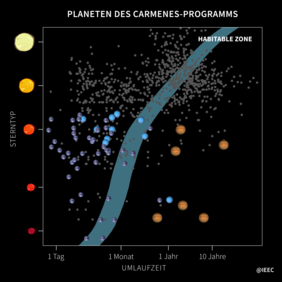The CARMENES project has just published data from around 20,000 observations taken between 2016 and 2020 for 362 cool stars, also called red dwarf stars. The project, funded by eleven institutes in Spain and Germany, uses an instrument whose construction and initial operating phase at the Calar Alto Observatory was led by the Landessternwarte Königstuhl. The aim of CARMENES is to search for Earth-like exoplanets, i.e. rocky planets with moderate temperatures.
The data now published are described in the journal Astronomy & Astrophysics. It is also the hundredth publication of the CARMENES consortium – impressive proof of the project's success in studying Earth-like exoplanets and their stars. In particular, the discovery of 59 new exoplanets deserves special mention. A dozen of them are potentially habitable: they are located in the so-called "habitable zone" of their star and could harbor liquid water on their surface.
In fact, CARMENES has doubled the number of known exoplanets of nearby cool stars. The publication of the first large data set enables other researchers evaluate the data and thus further increase the scientific benefit. The potential is great, because in the recently published data almost all of the brightest red dwarf stars observable from the northern hemisphere were recorded.
"I am particularly pleased that CARMENES has made it possible to carry out a total of 20 bachelor, master and doctoral theses at the Landessternwarte," says Professor Andreas Quirrenbach, head of the project. "Both technical topics related to the construction of the high-precision instrument and exciting questions about the investigation of planetary systems were dealt with." Dr. Jonas Kemmer examined two planets in more detail for his dissertation. He explains: "Through measurements from NASA's TESS satellite, we knew about the existence of these planets and were able to determine their radius from its data. CARMENES then made it possible to determine the density of these planets, which is very close to the density of the Earth. These planets probably consist of a rock material similar to that of our home planet."
Due to its great success, the project has been continued since 2021 as "CARMENES Legacy-Plus". The observations within the framework of this project extension will continue at least until the end of 2023 and will certainly allow some new discoveries, but above all they will serve a better statistical recording of the abundance of planetary systems.
The CARMENES instrument consists of two spectrographs that split visible and infrared light into its spectral components. It was built in 2010-2015 and then installed at Calar Alto Observatory to find Earth-like exoplanets orbiting nearby red dwarf stars. Their spectra reveal the existence of exoplanets, because by means of a tiny periodic redshift and blue shift of the lines in the stellar spectrum, the motion of the star can be measured, which is caused by the gravitational pull of the planets orbiting it. However, this poses a technological challenge, which is why many of the exoplanets known today have only been discovered in recent years. The high-resolution spectra of CARMENES enable an impressive accuracy of one meter per second, which makes it possible to find even very small planets around low-mass stars.
The current publication, which provides an overview of the data products and the discoveries made so far, was published in the journal Astronomy & Astrophysics. First author of the paper is Dr. Ignasi Ribas, researcher at ICE-CSIC and director of the Institute of Space Studies of Catalonia (IEEC - Institut d'Estudis Espacials de Catalunya). In total, around one hundred scientists from more than 30 research centres were involved in the study, including 14 from the Landessternwarte Königstuhl, which belongs to the Center for Astronomy at Heidelberg University (ZAH).
CARMENES is the name of the scientific project, but also of the instrument with which the observations were carried out and the consortium that designed and built it. More than 200 scientists and engineers from 11 Spanish and German institutions are involved in the project. The consortium consists of the following research centers: Max Planck Institute for Astronomy (MPIA), Instituto de Astrofísica de Andalucía (IAA-CSIC), Landessternwarte Königstuhl (LSW), Institut de Ciències de l'Espai (ICE-CSIC), Institut für Astrophysik Göttingen (IAG), Universidad Complutense de Madrid (UCM), Thüringer Landessternwarte Tautenburg (TLS), Instituto de Astrofísica de Canarias (IAC), Hamburger Sternwarte (HS), Centro de Astrobiología (CAB, CSIC-INTA) and Centro Astronómico Hispano-Alemán (CAHA).
ORIGINAL PUBLICATION
"The CARMENES search for exoplanets around M dwarfs. Guaranteed Time Observations Data Release 1 (2016-2020)", I. Ribas et al., published on February 22, 2023 in the journal Astronomy & Astrophysics (https://www.aanda.org/10.1051/0004-6361/202244879)
ADDITIONAL INFORMATION
Homepage of the Landessternwarte Königstuhl: www.lsw.uni-heidelberg.de
Homepage of the CARMENES consortium: https://carmenes.caha.es
Link to the published data: http://carmenes.cab.inta-csic.es/gto/jsp/datarelease1.jsp
SCIENTIFIC CONTACT
Prof. Dr Andreas Quirrenbach
Center for Astronomy at Heidelberg University (ZAH)
Landessternwarte Königstuhl (LSW)A. Quirrenbach@lsw.uni-heidelberg.de
LOCAL CONTACT FOR THE MEDIA
Dr Guido Thimm
Center for Astronomy at Heidelberg University (ZAH)
thimm@uni-heidelberg.de

